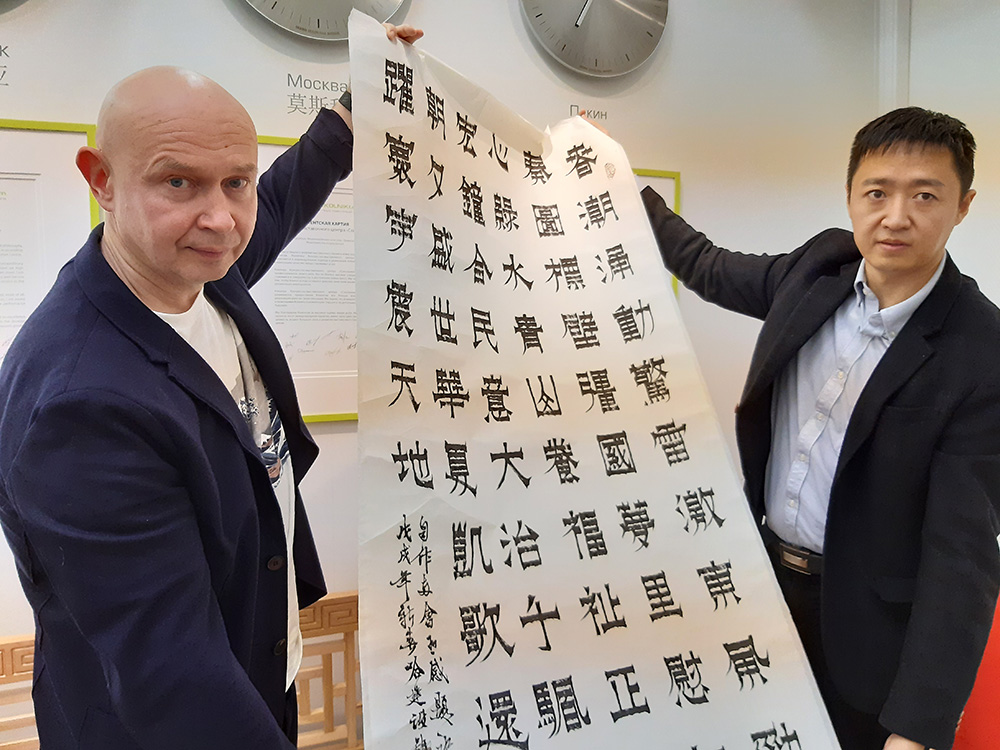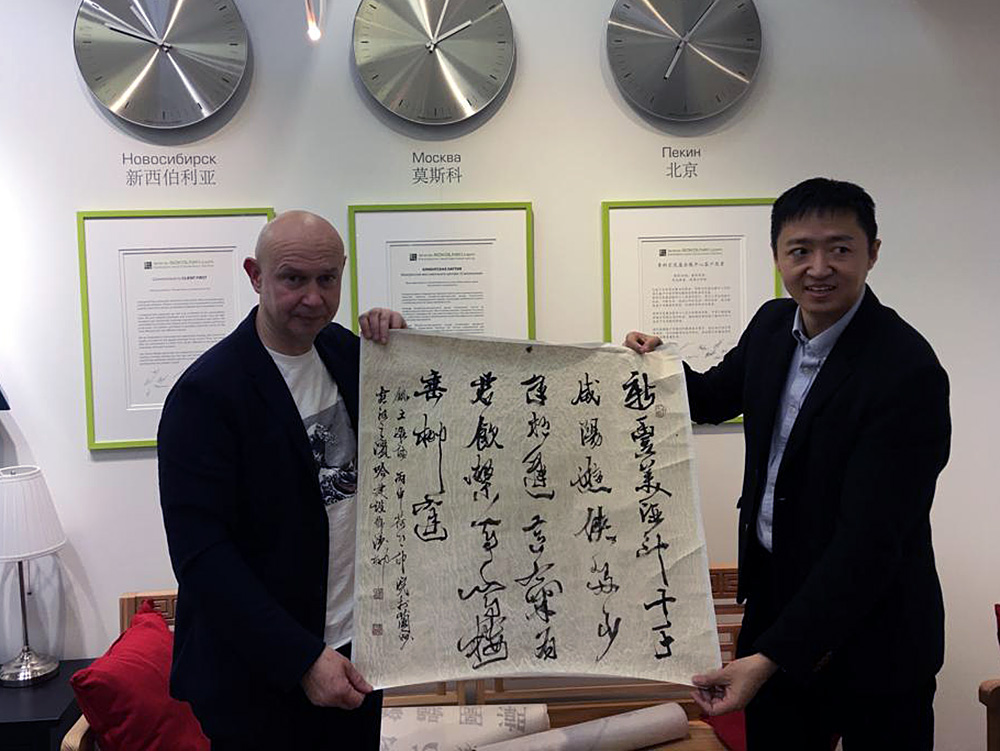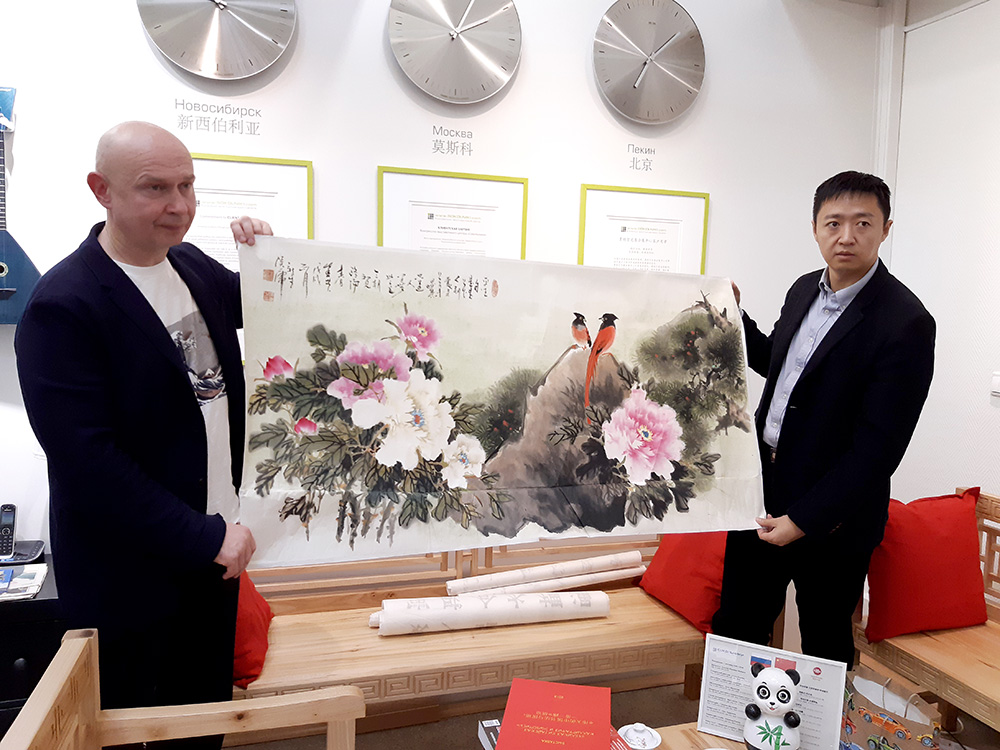Contemporary Museum of Calligraphy exhibits renowned calligraphers and artists from Gansu province
The Second Secretary for Science and Technology of the Embassy of the People's Republic of China to Russia visited the Contemporary Museum of Calligraphy on September 16, 2019.
Mr. Zhang Tian donated artworks by Ha Jianshe and Hou Yong, renowned Chinese calligraphers and artists, to Alexey Shaburov to be exhibited in the museum.
Ha Jianshe (born August 1956) is a registered senior trainer of the Chinese Association of Calligraphers, the Honoured President of the Chinese Association for Culture and Art, the Deputy Director of the Huaxia Institute for Fine Arts and Calligraphy of the Central Disciplinary Committee, member of Gansu Association of Calligraphers, and the Association of Writers. Gansu province party committee and government awarded him the “Contact with the Artists of China” title in 2010, and the “Dunhuang Literature Award” in 2012.
Ha Jianshe's artworks have been published in more than 20 newspapers and magazines, and collected in many Chinese and international museums, such as the art galleries of Tokyo, Nara, and Hokkaido (Japan).
 Ha Jianshe. “Impression of China’s Development in the New Era”
Ha Jianshe. “Impression of China’s Development in the New Era” Ha Jianshe artistically wields a broad creative manner. One of the works he donated, “Impression of China’s Development in the New Era,” is written in lishu handwriting, yet demonstrates specific individual original features. Lishu is second to zhuangshu primary style of Chinese writing, which used to be the official character style during Han dynasty (25-220 AD). Today it’s not in extensive use but rather serves as a decorative style, mostly resorted to by professional calligraphers or designers to reflect significance or solemn nature of a given text. Ha Jianshe created the above-mentioned artwork in March 2017 to celebrate the opening of the National People’s Congress and the Chinese People’s Political Consultative Conference.
 Ha Jianshe. “The Trip of a Young Man” (a poem by Wang Wei, Tang dynasty)
Ha Jianshe. “The Trip of a Young Man” (a poem by Wang Wei, Tang dynasty)The second Ha Jianshe's artwork to be exhibited in the Contemporary Museum of Calligraphy was created in summer 2015 during his meeting with fellow artists. It is made with the synthesized xing-cao handwriting (or “half-uncial cursive”), which is a combination of xingshu and caoshu styles. Xing-cao is designed primarily for artistic work and features characters flowing one into another as the artist’s pen rarely escapes paper. Xing-cao is a brilliant medium for the artist’s “chi” (life energy), which enhances its value among calligraphers.
Hou Yong (born 1946), is a member of Chinese Academy of Calligraphy and Fine Arts in Xinjiang autonomous district, Chinese Association for Research of Traditional Culture, and the Association of Poetry and Fine Arts in Gansu province. His artworks have been repeatedly exhibited in Chinese national and local events, or purchased for collections of many art institutions.
 Hou Yong. The Beauty of the Celestial Empire
Hou Yong. The Beauty of the Celestial Empire“The Beauty of the Celestial Empire,” donated to the Contemporary Museum of Calligraphy, is written in the ancient technique of sei, representing “flowers and birds” genre originated by one of the greatest Chinese artists Xu Xi, who lived approximately a thousand years ago during the Northern Song dynasty. The painting is one more author’s declaration of love to his country, inspired by a line from Li Bai, a poet of the Tang dynasty era: “Her robe is a cloud, her face a flower.”
Calligraphy — the written beauty of feelings.



